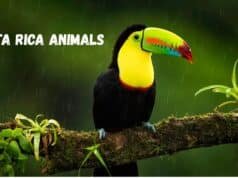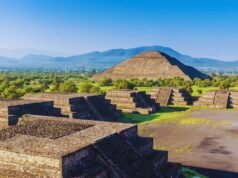Hidden within the sprawling urban landscape of Mexico City lies Lake Xochimilco, a vibrant reminder of the region’s ancient past and a living testament to sustainable coexistence between humans and nature.
Known for its colorful boats, tranquil canals, and lush floating gardens, Xochimilco is not just a scenic attraction; it’s a UNESCO World Heritage Site that preserves centuries of indigenous ingenuity.
Once part of a vast lake system that covered the Valley of Mexico, Lake Xochimilco remains a crucial ecological and cultural treasure at the heart of the modern metropolis.
Historical Background of Lake Xochimilco
Lake Xochimilco’s story dates back to pre-Hispanic times, long before the rise of the Aztec Empire. Early civilizations in the region developed sophisticated agricultural methods to adapt to the swampy terrain. The most ingenious of these innovations was the chinampa, or “floating garden,” a man-made island built from reeds, mud, and organic material, which allowed crops to thrive on the shallow lake waters.
When the Aztecs established their empire in nearby Tenochtitlan, they adopted and perfected the chinampa system, turning the area into one of the most productive agricultural zones in Mesoamerica. Even after the Spanish conquest and the draining of much of the Valley’s lake system, Xochimilco endured, continuing to supply food and life to the city that grew around it.
What Makes Lake Xochimilco Historically Important?
Lake Xochimilco’s history dates back thousands of years, making it one of Mexico’s most significant cultural landscapes. Long before the Spanish arrived, indigenous peoples, including the Xochimilca and later the Aztecs, developed advanced farming methods to survive in the swampy terrain. Their greatest innovation was the chinampa, or floating garden, which allowed them to grow crops on shallow lakebeds by layering mud and vegetation.
The chinampa system transformed Xochimilco into one of the most productive agricultural regions in Mesoamerica, capable of feeding large populations year-round. When the Aztec capital of Tenochtitlán was built nearby, these floating gardens became essential to sustaining the empire. Even after the Spanish conquest and the draining of most of the valley’s lakes, Xochimilco remained a fertile and vibrant center of farming and trade. Today, it stands as a living testament to indigenous ingenuity, demonstrating how early civilizations mastered sustainable agriculture long before the modern environmental movement began.
Related: Crowley Lake Columns
Geography and Environment of Lake Xochimilco
Today, Lake Xochimilco sits in the southern borough of Mexico City, covering an intricate network of canals, wetlands, and small islands. It represents the last remaining fragment of the once-vast interconnected lakes that sustained ancient civilizations. Despite being surrounded by one of the world’s largest urban areas, the lake maintains a delicate balance between natural and human activity.
Its wetlands serve as a natural filtration system for the city’s water and provide critical habitats for diverse species of plants, fish, and birds. The coexistence of rural life, ancient agriculture, and urban expansion makes Xochimilco one of the most unique ecosystems on Earth.
The Chinampa System
The chinampas of Xochimilco are often called “the floating gardens of Mexico,” though they are actually small plots of fertile land anchored to the lakebed. Farmers create these islands by layering aquatic vegetation and soil, which not only provides a nutrient-rich foundation for crops but also helps stabilize the wetland ecosystem.
These gardens have been cultivated for centuries, producing vegetables, flowers, and herbs in harmony with nature. In recent years, there has been a renewed effort to restore traditional chinampa farming, both to preserve cultural heritage and to promote sustainable agriculture in Mexico City. Many local farmers now collaborate with environmental organizations and chefs to reintroduce organic, locally grown produce from Xochimilco to the city’s markets and restaurants.
What Is Special About the Chinampa System?
The chinampa system is one of the most remarkable and sustainable agricultural techniques ever developed. Despite the name “floating garden,” chinampas are actually small, rectangular plots of land built on shallow lakebeds. Farmers constructed them by piling up layers of mud, reeds, and organic waste, which created rich, fertile soil ideal for growing crops. The surrounding canals provided a constant water source and a natural irrigation system, keeping the soil moist and nutrient-dense.
This technique allowed ancient farmers to harvest crops multiple times a year. Maize, beans, squash, and flowers thrived in these conditions. What makes chinampas truly special, however, is their ecological harmony: they filter water, prevent soil erosion, and serve as habitats for fish, birds, and insects. In modern times, environmentalists and local farmers have revived chinampa farming as a sustainable alternative to industrial agriculture. It’s a living example of how ancient practices can help solve today’s environmental challenges.
Flora and Fauna

Lake Xochimilco’s biodiversity is one of its greatest treasures. The most famous inhabitant is the axolotl (Ambystoma mexicanum), an extraordinary amphibian known for its ability to regenerate limbs and retain its larval form throughout its life. Native only to Xochimilco, the axolotl has become both a symbol of Mexican biodiversity and an international icon of endangered species.
The lake is also home to a variety of birds such as herons, ducks, and egrets, as well as native fish, aquatic plants, and insects. Together, they form a complex web of life that depends on the health of the water and the survival of the wetlands. Conservation programs are currently working to protect these species through habitat restoration and scientific research.
Read More: Delta Lake Hike
Tourism and Cultural Significance
Beyond its ecological value, Lake Xochimilco is one of Mexico’s most beloved cultural landmarks. Visitors flock to its canals to ride the trajinera, brightly painted wooden boats that glide gracefully across the water. Music from mariachi bands fills the air, while floating vendors offer food, drinks, and handmade crafts. It’s a lively scene that celebrates Mexico’s festive spirit while offering a glimpse into the country’s living history.
Festivals such as the Feria de la Flor (Flower Fair) and Day of the Dead celebrations bring even more color and tradition to Xochimilco, reinforcing its role as both a recreational space and a cultural heartland. However, with increasing tourism, there’s a growing emphasis on responsible practices to ensure that the beauty of the canals and the well-being of their ecosystem are maintained for generations to come.
Environmental Challenges
Despite its beauty and heritage, Lake Xochimilco faces significant challenges. Urban expansion, pollution, and the over-extraction of groundwater have disrupted its natural balance. The reduction of clean water inflow, combined with the introduction of invasive species, threatens the delicate habitats that sustain native flora and fauna.
Efforts are being made to reverse this decline. Local farmers, environmental groups, and government agencies have launched initiatives to clean the canals, replant vegetation, and regulate tourism. Reviving the chinampa system and raising awareness about sustainable practices are central to ensuring that Xochimilco continues to thrive as both a natural and cultural landmark.
Lake Xochimilco Today
Today, Lake Xochimilco stands as a remarkable fusion of past and present. It remains a working agricultural zone, a cultural hub, and an ecological sanctuary all within one of the world’s largest cities. Ongoing restoration projects aim to improve water quality, protect endangered species like the axolotl, and reintroduce traditional farming methods.
For locals, Xochimilco represents pride and heritage; for visitors, it offers a window into the soul of ancient Mexico, where nature, innovation, and celebration come together in harmony.
Why Is the Axolotl So Important to Lake Xochimilco?
Perhaps the most famous resident of Lake Xochimilco is the axolotl, a unique amphibian known for its ability to regenerate limbs and even parts of its heart and brain. Scientifically named Ambystoma mexicanum, this species is found only in the waters of Xochimilco, making it a symbol of both the lake’s biodiversity and its fragility. The axolotl’s biology has fascinated scientists worldwide, leading to research in regenerative medicine and genetics.
Unfortunately, the axolotl is now critically endangered. Urban expansion, water pollution, and invasive species have devastated its natural habitat. However, conservation programs are working tirelessly to restore its population. Local initiatives, breeding centers, and sustainable farming practices within the lake’s canals aim to improve water quality and create safe breeding zones. The axolotl’s survival depends on the health of Xochimilco’s ecosystem; protecting one means protecting the other. For Mexico, the axolotl isn’t just an animal; it’s a cultural emblem, a scientific marvel, and a call to preserve the environment.
Read Also: Tourists Disregarding Warning Signs Crater Lake
Why Do Tourists Love Visiting Lake Xochimilco?
Visiting Lake Xochimilco is like stepping into another world, one where time slows down and color takes over. Tourists come from all over the globe to ride the trajinera, the brightly painted wooden boats that glide through the canals. These boats are often decorated with flowers and the names of loved ones, creating a festive atmosphere unlike any other. As visitors float along, they can enjoy live mariachi music, sample traditional Mexican food from floating vendors, and watch families celebrating birthdays or holidays right on the water.
Beyond the fun and festivity, Xochimilco offers travelers a glimpse of authentic Mexican culture and history. The floating gardens, ancient canals, and lively community reveal a side of Mexico City that’s both traditional and timeless. Responsible tourism efforts now encourage visitors to respect the fragile ecosystem, ensuring that future generations can continue to enjoy this beautiful fusion of culture, nature, and joy.
What Threats Does Lake Xochimilco Face Today?
Despite its beauty and heritage, Lake Xochimilco faces serious environmental challenges. Rapid urbanization in Mexico City has led to pollution, habitat loss, and the overuse of groundwater, all of which threaten the delicate wetland ecosystem. The canals often suffer from contamination due to waste and runoff, and invasive species compete with native plants and animals for survival.
The decline of traditional chinampa farming has also impacted the lake’s ecological balance. As fewer locals maintain the floating gardens, sediment buildup and water stagnation have increased. Fortunately, a growing number of environmental organizations and local communities are working to restore Xochimilco through reforestation, canal cleaning, and the promotion of sustainable agriculture. These collective efforts underscore a shared understanding that preserving Xochimilco entails protecting not only biodiversity but also Mexico’s cultural identity and historical heritage.
Also Read: Alpine Lake Idaho
How Is Lake Xochimilco Being Preserved for the Future?
In recent years, Lake Xochimilco has become a focal point for conservation and education efforts. The Mexican government, NGOs, and local farmers have joined forces to rehabilitate the canals, reintroduce native plants, and revive traditional farming methods. Eco-tourism programs now promote sustainable visits, emphasizing cultural respect and environmental awareness. Educational initiatives teach younger generations about the importance of wetlands and indigenous agricultural techniques, inspiring community involvement.
Scientists are also collaborating with local authorities to monitor water quality, protect endangered species like the axolotl, and explore green solutions to urban pollution. The success of these programs depends on balancing modern city life with ancient ecological wisdom, a challenge, but one that continues to inspire progress. In every sense, Xochimilco remains a living classroom, showing the world that harmony between humanity and nature is still possible.
Conclusion
Lake Xochimilco is far more than a picturesque destination. It is a living legacy, a place where ancient ingenuity continues to shape modern sustainability, and where history flows through every canal. Preserving Xochimilco means protecting not just an ecosystem, but also a vital link to Mexico’s cultural identity and its ongoing relationship with nature. In a city that never stops growing, Xochimilco endures as a quiet yet powerful reminder of balance, resilience, and beauty.















